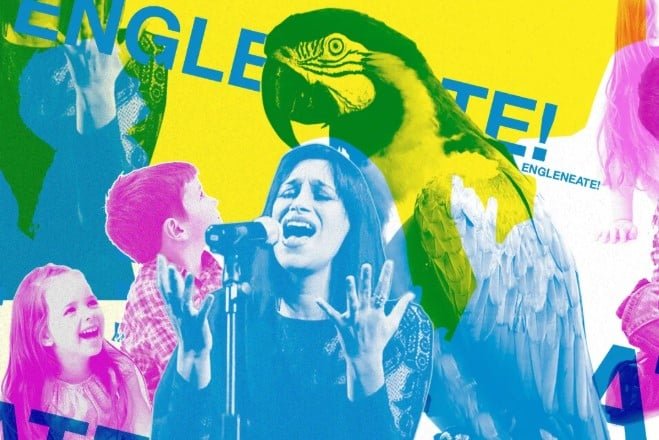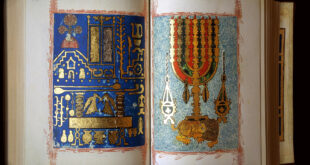The sixth annual event at the UW headlines with French Sephardic activist Francois Azar.

A parrot perches in front of a packed synagogue on Rosh Hashanah. Advertised as “a Jewish parrot” (“un papagayo djudió”) at Bloomingdale’s, the bird had amazed his new owner, a wealthy merchant from Istanbul, with performances of Hebrew prayers. Yet now, with the whole community watching (and a $50,000 donation on the line), the parrot won’t sing.
Slightly surreal, darkly humorous, this folktale embodies qualities typical of the Sephardic oral tradition. After their expulsion from Spain in 1492, Jews who settled in the Eastern Mediterranean, the Balkans, and North Africa incorporated elements of local stories into their folktales, just as they folded new words into their language, Ladino, also known as Judezmo or Judeo-Spanish.
The genre of Sephardic folktales will be the focus of Seattle’s sixth annual International Ladino Day on December 5 at the University of Washington. Ladino Day, instituted in 2013 by the National Authority for Ladino, in Jerusalem, to celebrate and raise awareness of the endangered language, has become a hallmark of the UW Sephardic Studies Program. Consistently drawing hundreds of audience members, Ladino Day has featured performances by the Ladineros — a group of Seattle-based Ladino speakers that meets weekly — alongside readings, lectures, and music. This year, French Sephardic activist and publisher François Azar will headline.
“The event seems to transcend a variety of disciplines and communities — a dynamic that has been very rewarding for the bridges it helps to build,” says Devin Naar, the Isaac Alhadeff Professor in Sephardic Studies at UW. Under Naar’s leadership, the program has earned international acclaim since its establishment in 2011. It now operates a digital library with the largest collection of Judeo-Spanish materials in the world. Most of the manuscripts and artifacts emerged from Seattle’s own Sephardic community.
Both Naar and Azar are putting their respective cities at the center of the modern resurgence of Ladino culture. Azar leads Aki Estamos –

Les Amis de la Lettre Sépharade, a Paris-based group established in 1998 to ensure the transmission of Sephardic culture to younger generations. He runs a Ladino summer program in France and is the founding publisher of Lior éditions, an imprint seeking to promote Judeo-Spanish culture. Through his new press, Azar has published two illustrated, Ladino-English volumes of folktales: The Jewish Parrot and Other Judeo-Spanish Tales (2014), which includes the curious tale of the stubborn parrot, and Bewitched by Solika and Other Judeo-Spanish Tales (2016). A third volume, featuring his original stories, came out in March.
Naar’s decision to bring Azar to Ladino Day this year was a conscious one. Now the father of two young sons, Naar speaks Ladino in his home in an effort to replant his own family’s ancestral language in a new generation. Azar’s books are “the first illustrated Ladino tales published with a youth audience in mind,” Naar says.
Azar traces his roots to the Greek island of Corfu and the Turkish city of Smyrna (now Izmir). His passion for Sephardic culture began with cooking traditional cuisine. This led to his involvement with Aki Estamos, learning Ladino, and engaging children with Sephardic culture. “After working with children, I tried to involve all kinds of creative young people — musicians, singers, designers, painters, writers — in projects with a Judeo-Spanish theme,” he says. “This is an approach that is at the heart of the foundation of Lior éditions: to bring Judeo-Spanish culture to life by reinterpreting it in a very contemporary way.” The Jewish Parrot includes new Ladino tales by children who submitted entries through a contest.
Transmitting knowledge of Ladino to future generations is a path that other Ladino activists are also paving. Sarah Aroeste, a classically trained singer and self-described “artist with a mission” who has dedicated her career to creating original Ladino music, released the children’s album Ora de Despertar (Time to Wake Up) in 2016. “I searched high and low for collections of materials specifically for kids that were entertaining and educational in Ladino, and I couldn’t find any,” she says. “That was really the impetus for Ora de Despertar. I wanted new songs with secular themes like waking up in the morning, mealtimes, animals on a farm, so that Ladino would be normalized.”
Aroeste created a storybook and an animated series to give families complementary resources. Yet a significant need remains for easy and accessible Ladino materials. “Kids can’t do it alone,” Aroeste says. She created a teaching guide for parents and educators and hopes to lead regional trainings.
Savvy about technology, networking, and outreach, Ladino activists are operating with “a heightened awareness,” as Aroeste says, “that we need to start doing something to preserve our culture.”
Whether such efforts successfully revitalize the Ladino language, though, remains to be seen — and ultimately will be hard to measure. Gauging the precise number of contemporary Ladino speakers is notoriously difficult, according to Molly FitzMorris, a PhD candidate in linguistics at UW and co-organizer of Ladino Day. “In language endangerment situations, because of ongoing language shift where virtually every individual speaker has a unique competence, you really do have to ask what is meant by ‘speaker,’” she says. Census data on Ladino proficiency is scarce, and language engagement (as opposed to fluency) is almost as slippery to measure.
That said, enthusiasm around efforts to revive Ladino are evident. Azar reflects on this shift from the vantage point of Aki Estamos. “We are in a world so small that only one person can make a difference,” he says. In its second decade, the organization doubled its membership despite losing over half of its founding members. “We have gained a lot of ‘new Judeo-Spanish people,’” he says.
Seattle Ladino Day’s successful track record, combined with the excitement generated by the Sephardic Studies Program both locally and in virtual spaces, confirms Azar’s observation that it is well worth investing the time in engaging new audiences.
“The big difference is that these new members do not come to share a culture and language they already know, but they are looking for what has not been passed on to them,” Azar says. “It is therefore necessary to show them that it [Ladino] is worth it by bringing joy and beauty into their lives.”
Ladino Day 2018: The World of Judeo-Spanish Folktales takes place December 5 at 7 p.m. at UW Kane Hall 130. More information at jewishstudies.washington.edu
 eSefarad Noticias del Mundo Sefaradi
eSefarad Noticias del Mundo Sefaradi

